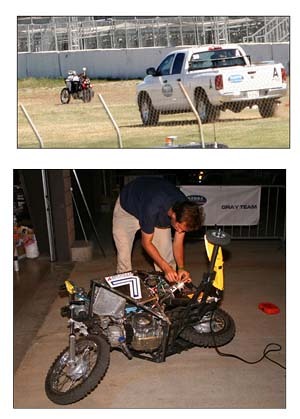"Blue Team" runs self-righting motorcycle at DARPA Grand Challenge
Fontana (CA) - The Blue Team's autonomous motorcycle "GhostRider" has always been an underdog at the Grand Challenge as no one expects a two-wheeled vehicle to successfully compete against SUVs, ATVs, and other off-road vehicles. GhostRider put up a good fight by going through about 50 percent of the course the first time and a little bit farther the second.
The Berkeley, Calif.-based, Blue Team, led by Anthony Levandowski takes on the DARPA Grand Challenge with different and apparently less sophisticated technology than its competitors with more wheels. Their GhostRider vehicle does not use any lasers or radar for obstacle avoidance, but employs a pair of 1600 x 1200 resolution cameras that provide a 3D image of upcoming terrain instead. Another color CCD camera is used for road detection. Last year, the motorcycle did not make it out of the starting gate and fell over several times. Learning from that mistake, Levandowski added an ingenious self-righting ability to the bike.
On its first qualification run, GhostRider sped out of the starting shoot and appeared to hit either a cone or the first metal sheeting wall. It fell over and the crowd thought the motorcycle was finished, however, struts resembling training wheels popped out and sprang the motorcycle upright. GhostRider then continued onto the straight away course to the cheers of spectators and competitors - such as the Carnegie Mellon team - alike.
Just before the plywood tunnel, GhostRider hit a hay bale on the left side and fell over. It attempted to upright itself several times and we could see it try to come off the ground. Apparently, it was propped up the hay and the struts couldn't give the motorcycle enough length to fully stand up. Eventually, race officials disabled the vehicle.
On another run, the motorcycle made it a bit farther but fell over when it hit obstacles in the debris field. GhostRider failed to get back up, because it was propped up on a tire. Levadowski told us that the software has been rewritten to fix the problem. Like some of the other vehicles at the NQE (National Qualifying Event), GhostRider has avoided obstacles by going outside of the DARPA course boundry. Near the start line, there are two sheet metal walls that the contestants must go between, but GhostRider chose to go completely around both of them. The vehicle also veered to left and went around a plywood tunnel that vehicles must drive through.
On Sunday afternoon, GhostRider searched for some spare metal to replace damaged parts of the self-righting struts. Even though the teams are competing for a prize of $2 million, members of other teams walked up and offered to help with welding or by providing parts. Late into the night, after most of the lights were turned off in the other garages, Levadowski and his team were still working on GhostRider.
Get Tom's Hardware's best news and in-depth reviews, straight to your inbox.
Humphrey Cheung was a senior editor at Tom's Hardware, covering a range of topics on computing and consumer electronics. You can find more of his work in many major publications, including CNN and FOX, to name a few.
